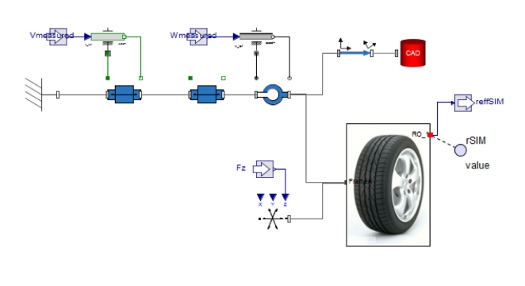 |
| July 25, 2017 | Volume 13 Issue 28 |
Designfax weekly eMagazine
Archives
Partners
Manufacturing Center
Product Spotlight
Modern Applications News
Metalworking Ideas For
Today's Job Shops
Tooling and Production
Strategies for large
metalworking plants
Engineer's Toolbox:
MapleSim provides new approach to tire modeling
Tires are a critical component in vehicle design. To save time and money in the design and development of new vehicles, automotive manufacturers typically use models to simulate the dynamic relationship between tires and road surfaces. Ideally, a tire model must accurately simulate the dynamics of the system and allow designers to vary its parameters, and simulations must also execute quickly.
Existing tire models have inherent drawbacks. Some existing tire models, such as the Pacejka magic formula tire model, are based solely on experimental data. Alternatives, such as finite element models, are extremely resource intensive, while other tire models represent the tire with a physical object, such as a string or brush. None of these models achieve an ideal balance of accuracy and efficiency. However, researchers at the University of Waterloo in Ontario, Canada, are taking a new approach to tire modeling with the ultimate goal of achieving this ideal balance.
The research team, led by Dr. John McPhee, Professor of Systems Design Engineering, and Dr. Joydeep Banerjee, Lead Researcher, used Maplesoft's system-leveling modeling tool, MapleSim, to develop and test a volumetric tire model. "The volumetric tire model developed in MapleSim offers two distinct advantages over existing tire models," said Dr. Banerjee. "Since the moments are calculated using kinematic data only, the model can be easily programmed for numerical simulations. In addition, the resistive torques are evaluated as functions of both normal load and angular speed of the wheel."

MapleSim was used to develop and test a volumetric tire model.
Using Maple, Maplesoft's advanced computation engine, the symbolic expressions for the normal force and rolling resistance were derived as a function of the position and orientation of the tire. The distributed friction forces were symbolically integrated over the tire contact patch to calculate the traction forces and self-aligning moments. The researchers then used MapleSim to develop the model using custom components derived from the Maple expressions.
To test the accuracy of the volumetric tire model, the model was used in a simulated drop test. An actual drop test was performed on a MICHELIN 195/65 R15 summer tire inflated to 33 psi. The tire model was assembled to undergo the same motion as the actual drop test. Using MapleSim, the drop and rebound of the tire were simulated. Another commercially available tire model, selected from MapleSim's extensive Tire Library, was also used to compare the results. When comparing the results of the two models, the MapleSim volumetric tire model provided a slightly more accurate estimate for the position of the wheel.
Initial results indicate that the MapleSim volumetric tire model is promising for use, not only for automobile tires, but for tires with higher camber angles, such as bicycle and motorcycle tires. To increase the fidelity of the model, the researchers plan on further testing of the volumetric tire model using data obtained from a Vehicle Measurement System (VMS). The VMS will provide information on the position, orientation, and loads placed on the tire during actual driving tests of a vehicle.
"While the initial results from the model look promising, the data from the VMS can be used to further fine tune the parameters of the tire model," said Dr. McPhee. "Using MapleSim, we can take the analysis further by easily incorporating the tire model into detailed vehicle models for complete vehicle systems simulations."
* At the time of this research study, Dr. Joydeep Banerjee was a member of Dr. McPhee's research team at the University of Waterloo. He is now employed with Maplesoft as an Application Engineer.
Source: Maple
Published July 2017
Rate this article
View our terms of use and privacy policy
